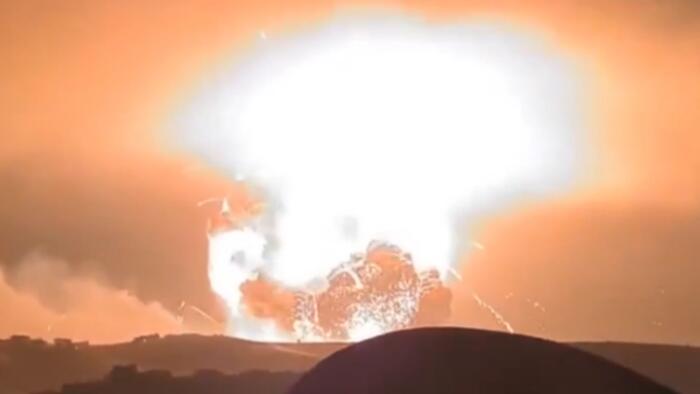In the past few days, Israel intensified its military operations against what remains of the Syrian military infrastructure, using heavy bunker buster munitions to target underground missile and weapons storage facilities. These operations commenced during the night with Israeli warplanes launching significant strikes on air defense systems and ammunition depots in key locations such as Damascus and the coastal city of Tartous, which is strategically close to a Russian naval base. The bombing in Tartous resulted in a massive explosion that generated a fireball and mushroom cloud, prompting speculation that it could have involved tactical nuclear weapons; however, this theory has been largely dismissed by various reports. Israeli forces also struck an arms depot in Bmalkeh, causing extensive damage and breaking windows across the surrounding areas, though casualty figures remain undisclosed.
The London-based Syrian Observatory for Human Rights (SOHR) reported that the Israeli airstrikes focused on degrading Syria’s military capabilities. SOHR characterized these attacks as the most intense the region has experienced in over a decade. Notably, a tremor with a magnitude of 3.1 was detected by Israel’s seismology department at the time of the bombings, further underscoring the scale of the explosions. Al Jazeera’s reporting indicated that the blasts were exceptionally loud, with some experts suggesting that they may have originated from a chemical weapons production facility due to the nature of the explosion and the areas targeted.
In total, Israeli forces reportedly conducted approximately 600 strikes over a span of eight days. Many of these strikes were initiated as the militant group Hayat Tahrir al-Sham (HTS) encroached upon Damascus, coinciding with the retreat of President Bashar al-Assad. Israeli sources have indicated that the overarching goal of these operations is to cripple the Assad military, ensuring that various assets, including tanks and missiles, do not fall into the hands of opposing forces, particularly militant groups. This determination to neutralize Syrian military capabilities reflects a broader strategic objective focused on maintaining regional stability and preventing the resurgence of armed factions.
The strikes have not only targeted ground munitions and air defenses but have also included efforts to destroy jets, aerial equipment, and runways at military bases. This systematic dismantling of the Syrian military serves multiple purposes for Israel. One key aspect is the intent to prevent the emergence of pro-Iranian groups in Syria, including Hezbollah and various Shia militia networks. By choosing to attack now, Israel seems poised to decisively weaken any future threat from these factions, particularly in light of plans for possible shifts in power dynamics within Syria.
As Israel carries out these operations, questions about Syria’s future governance loom large. There is speculation that once the current regime of Assad collapses, a new government could emerge, most likely dominated by hardline Sunni factions. This potential change could profoundly alter the political landscape of the region, with implications for both local ethnic and sectarian groups, as well as broader geopolitical interests involving other nations in the Middle East. The uncertainty surrounding this political evolution adds another layer of complexity to the ongoing military engagements.
In conclusion, Israel’s extensive air campaign against Syrian military assets marks a significant escalation in the conflict, driven by strategic objectives that involve dismantling Assad’s military capabilities and mitigating the influence of Iranian-backed groups in the region. The scale of the bombings, characterized by remarkable explosions and tangible seismic effects, reflects a level of intensity not seen in years. As this situation unfolds, the ramifications for both Syria and regional stability remain deeply uncertain, particularly as various internal and external stakeholders reevaluate their positions in a rapidly changing landscape. The international community watches closely as developments in Syria may set the tone for future engagements and conflicts in the broader Middle Eastern context.

